How To Find Open Ports On Network
Before I had written a mail on how to detect WiFi leechers on your network and mentioned a couple of smartphone apps you could use to scan your home network. The apps do a pretty good job of scanning your network automatically and giving y'all some details on each device.
I didn't get into much item nearly the apps in that post since it was focused on communicable unauthorized users on your network. In this article, I'll talk in more than detail nigh these two apps that can be used on Apple or Android devices and I'll as well mention desktop apps that you can run on Windows and Mac Os X.
These network scanning tools allow you lot to not just see all the devices on your network and their IP addresses, but as well view folders shares, open TCP/UDP ports, hardware MAC addresses and more. So why would you care about this information?
Though it's a scrap technical, the information can assist you make your network more than secure. For case, you may find folders that are beingness shared on your network past accident. Anyone who connects to your network via cablevision or wireless could then hands search for shared folders and copy that information to their computer.
When looking at open ports for a computer or device, you tin can hands see whether remote desktop is enabled, whether an FTP or HTTP server is running and whether file sharing is enabled or not. If you never connect to your figurer remotely, then having remote desktop enabled is merely a security hazard.
Windows Network Scanner
Let'due south first off with a complimentary tool for Windows PCs chosen SoftPerfect Network Scanner. I like this tool because it's updated often, runs on Windows x and has a 32-scrap and 64-flake version. The program also doesn't require any installation, which means you can deport it on a USB stick or relieve it to Dropbox and use it on any computer you want.
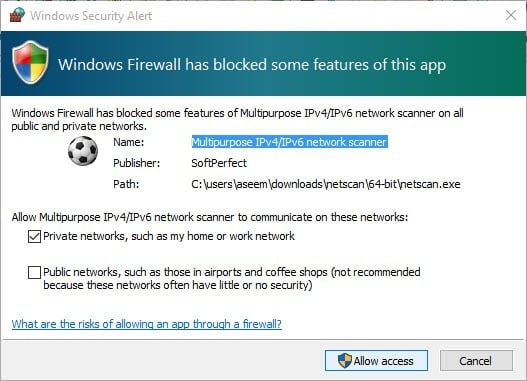
When you run the executable file for your version of Windows (determine if you have 32-chip or 64-bit Windows), you might run into a bulletin saying that Windows Firewall has blocked the program. Brand certain Private networks is checked and then click on Allow access.
Once the program loads, you'll need to enter your network starting and ending IP accost range. If yous don't know this, don't worry. Just click on Options, IP Accost then click on Automobile Find Local IP Range.
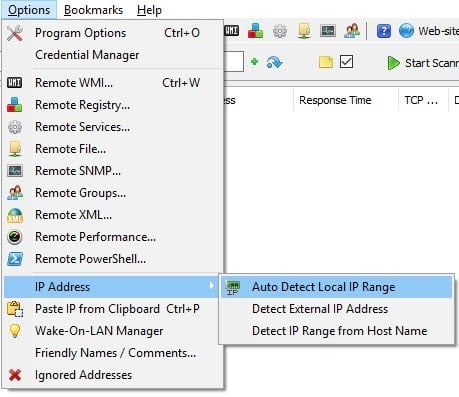
You'll get a popup window with the detected IP addresses for IPv4 and IPv6 on whatsoever network cards you lot have installed, including virtual ones. For most habitation users, you're only going to see ane item listed under both IPv4 and IPv6. Unless you lot have IPv6 setup, you should click on the network card listed under IPv4.
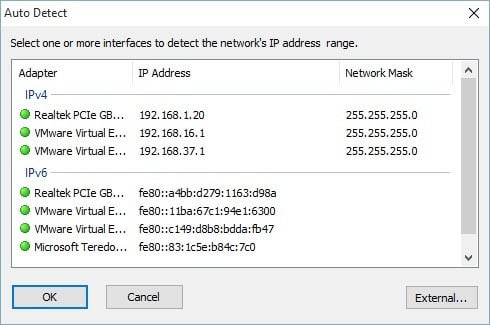
Now you'll be brought to the main interface over again, merely now the IP address range will be filled in. You lot'll come across the Start Scanning push button at the correct, which y'all can click to first a scan.

However, you should offset set the scanning options before performing a scan. Click on Options and and so Plan Options. On the General tab, the but option you may desire to check is E'er analyze device. By default, the scanning program volition but show you devices that answer to certain requests, so the final list may non show all the devices that are actually on your network because some devices just exercise not respond.
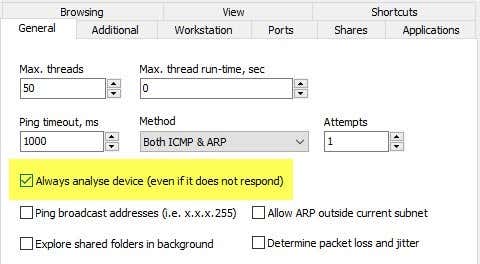
The browse does have quite a bit longer (several minutes compared to several seconds), simply it'due south worth it if you actually desire to see every device on your network. The Additional and Workstation tabs are really only useful for corporate environments where you take many machines on the same network and yous want to get information nearly each computer. The Ports tab is where nosotros can to get next.
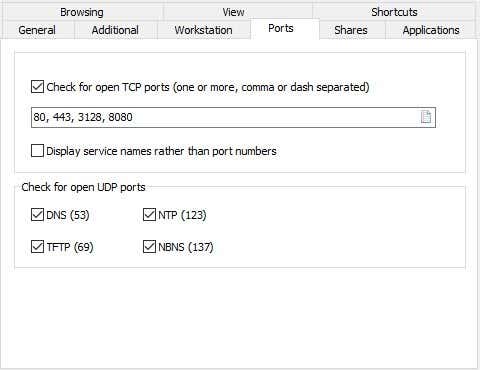
Check the Bank check for open TCP ports box and then click on the footling paper icon at the far right of the text box. This will open another window that lists out some TCP port groups. You lot want to click on HTTP and Proxy and then press the SHIFT key and click on Database servers to select all three items.
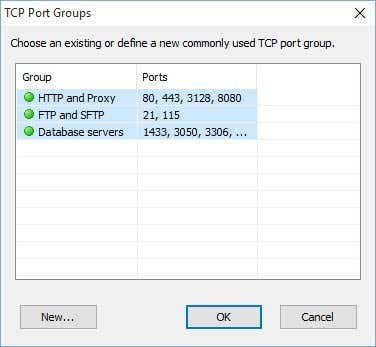
Back on the main screen, you should see all the port numbers listed in the text box. Go alee and besides cheque all the boxes for open UDP ports. At this betoken, click OK to go back to the main program screen. At present click First Scanning and you should see results slowly added to the list.
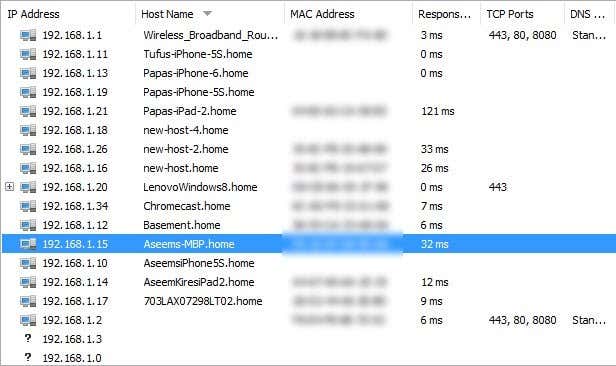
In my tests, the programme was able to find 16 devices on the network when checking the Always analyze device choice compared to just 11 items when non checked. Any item with a plus sign to the left of the IP address means that it has shared folders. You can click on the + sign to see the shared folders.
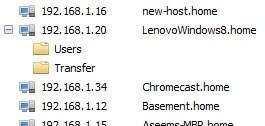
The Host Proper noun column should give you an piece of cake to empathise proper name for the device. On the right, you'll see a column called TCP Ports, which will list out all the open ports for that device. Obviously, the numbers don't make much sense unless y'all know what they means, so check out this Wikipedia folio that describes each port number in detail.
If anything has port 80 (HTTP) listed, that usually means it has some kind of web interface and yous can effort connecting to it via your browser by merely typing in the IP address. Port 443 is for secure HTTP (HTTPS), which means you tin can connect to information technology deeply besides.
Mac Network Scanner
On the Mac, you have a couple of options. LanScan is a free app on the Mac Store that does a very simple scan and displays the IP address, MAC address, Hostname and Vendor. The costless version volition only list the first four hostnames fully and the residual will only show the outset three characters. A little annoying, merely probably not a huge deal on most home networks.
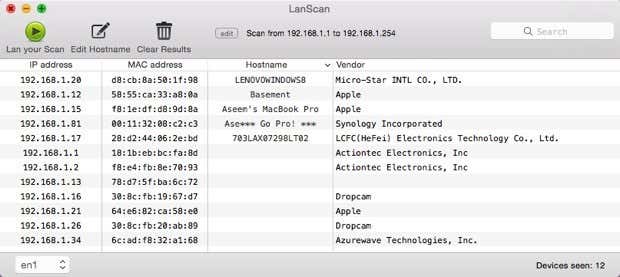
You lot'll too observe that it but constitute 12 items and that's because it doesn't take whatsoever options to scan each IP accost regardless of whether it responds or not. A better network scanner for the Mac is Aroused IP Scanner shown below. It's open source and works on Windows, Mac and Linux.
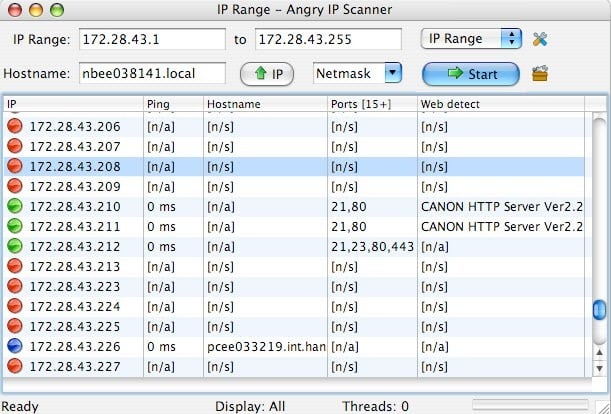
By default, the program also scans open ports, which LanScan does not practice. The merely issue with this program is that you have to accept Java installed in order to run the program. Java is a big security risk and is disabled on most Macs past default, then you would have to enable it manually.
Smartphone Apps
I have 2 apps that I use, both of which are free, and one that can you lot download on Apple devices or Android devices. Both apps are splendid and pretty much give you the same info, merely each has its pluses and minuses.
Fing is a gratis app that is available on the Google Play store and the iTunes store and has a swell looking interface. You don't have to worry about entering any IP address range with these apps considering they figure it out on their own. Once you start a scan with Fing, yous'll become a nice looking list of devices with some basic info similar hostname, MAC address, IP accost etc.
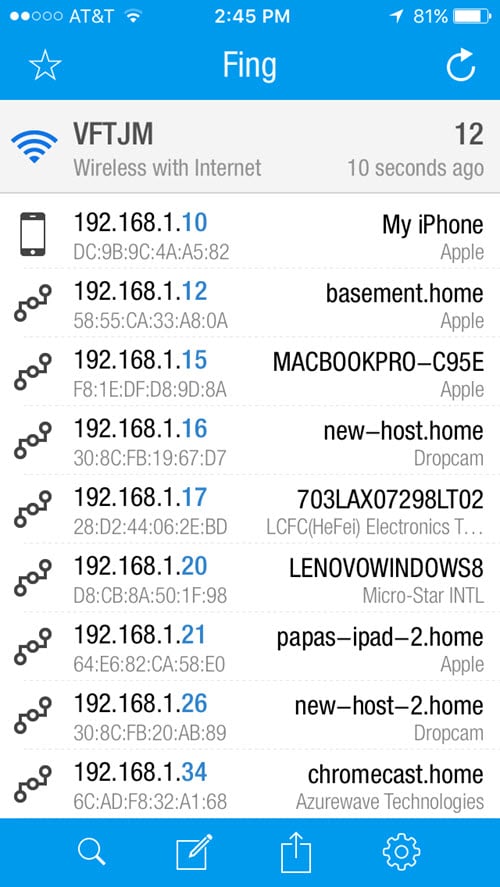
If you tap on a device, you'll get some other screen where you can give the device a custom proper noun (a feature I really like), enter a location and even add boosted notes. If you curlicue down, you'll see an choice called Services, which lets yous run across scan the device for open up ports.
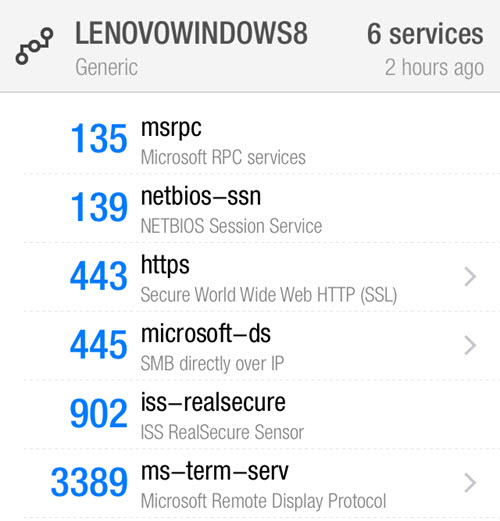
The only downside I take seen with this app is that it doesn't list out all the devices on the network. Information technology simply caught virtually 12 devices on my network out of the 16 that the Windows program had found.
The second app I like using is Cyberspace Analyzer, available from the App Store for costless. You run a scan by tapping the Scan button at the top right and yous'll get a list of all your devices within a few seconds.
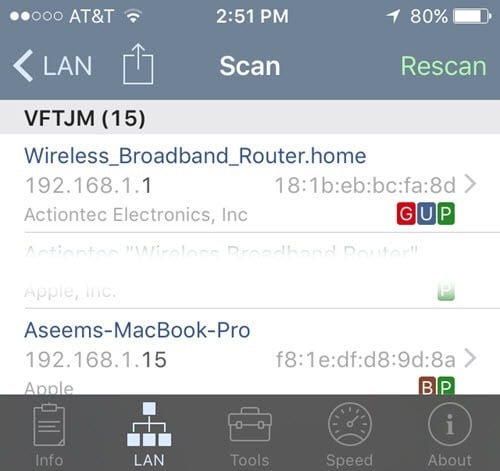
Using this app, I got 15 devices, which was pretty close to the total number of devices on the network. With Net Analyzer, y'all'll also see some colored letters on devices that have sure services enabled. The dark-green P means it is pingable, the brown B ways Bonjour services are available (Apple tree devices), the ruby G means it'south a gateway device (router, etc), and a bluish U ways UPNP and DLNA services are bachelor.
You can tap on a device to get more information and perform queries on the device. Tap the Query with Tools option shown below one time you tap on a particular device.
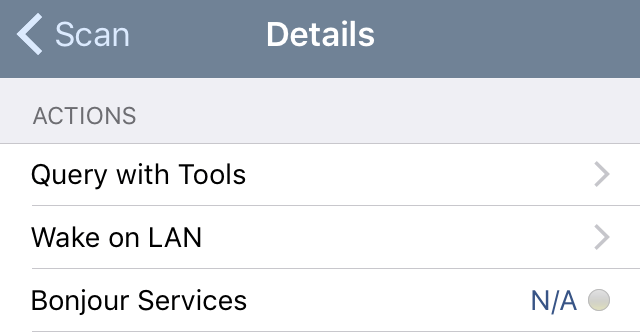
On the next screen, you'll see several options including Ping, Route, Ports, Whois and DNS. Tap on Ports, choose Mutual or All and and then tap Start at the elevation.
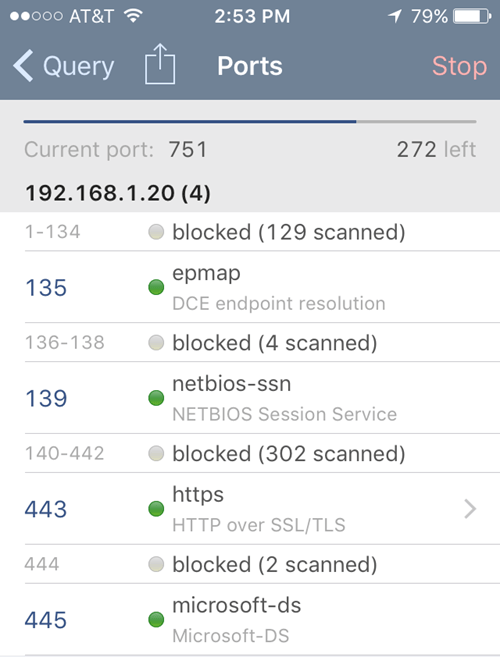
Every bit the browse progresses, you'll run across the ports that are open and agile and likewise which ports are blocked. The app also has other tools that you can utilise to scan specific devices on the network to get more than information.
Hopefully, these tools will permit y'all to fully see what devices are on your network and what services and ports are open. If you lot have whatsoever questions, feel free to post a annotate. Bask!
Practice not share my Personal Information.
Source: https://www.online-tech-tips.com/software-reviews/free-advanced-network-ip-and-port-scanner-security-tool/
Posted by: gravescolmilluke.blogspot.com


0 Response to "How To Find Open Ports On Network"
Post a Comment